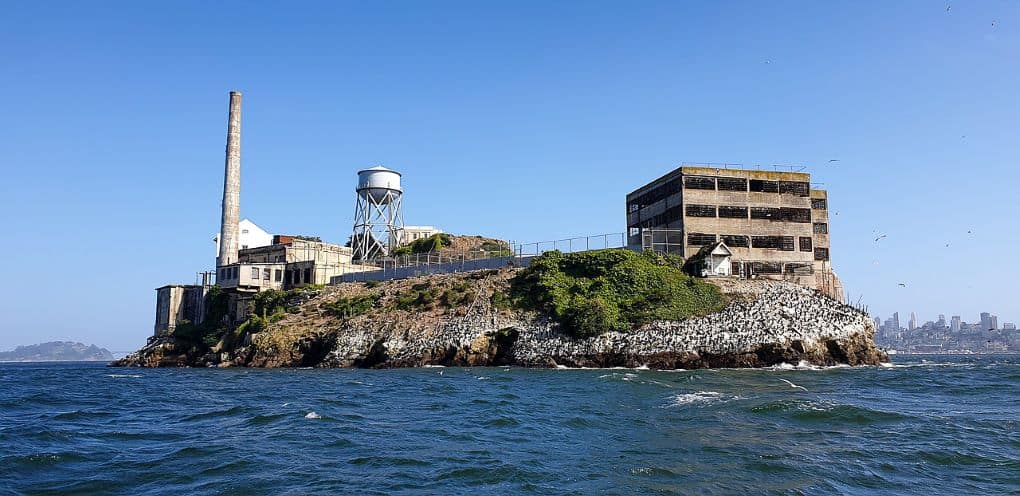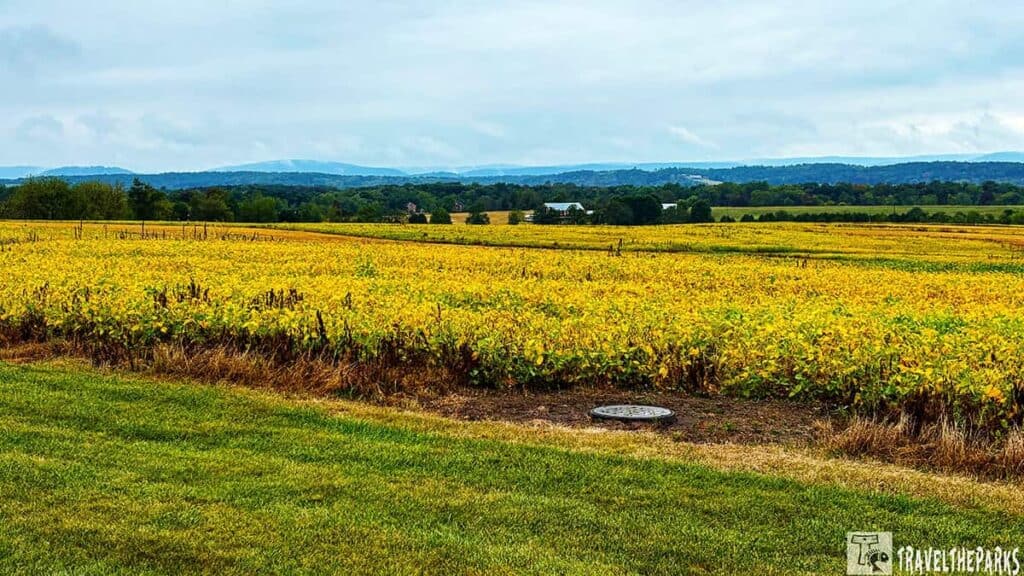One of the most prominent landmarks, “the Rock” of Alcatraz Island, is a mere 1.25-miles from the shores of San Francisco. More than just a rock outcropping, the birds have reclaimed it. The ruins of this formidable island prison make for the perfect natural habitat for nesting birds. Alcatraz Island is part of the Golden Gate National Recreation Area. The Golden Gate National Recreation Area is huge and includes Point Reyes, Fort Point National Historic Site, and Muir Woods National Monument along with other natural historic places.

A cruise to the island requires advanced ticket purchase. This is an extremely popular tour for those visiting San Francisco. The online tickets sell quickly. I purchased my ticket a few months prior to my trip. Alcatraz Island, “the Rock” was on my radar since watching the Clint Eastwood movie “Escape from Alcatraz” when I was a teenager. They based the film on the true story of three inmates who attempt a daring escape from the infamous prison. Although no one had escaped before, bank robber Frank Morris masterminded this elaborately detailed, and, as far as anyone knows, ultimately successful, escape.

This post may contain affiliate links, meaning if you purchase something through one of these links, we may earn a small commission at no extra cost to you! Read the full disclosure policy here
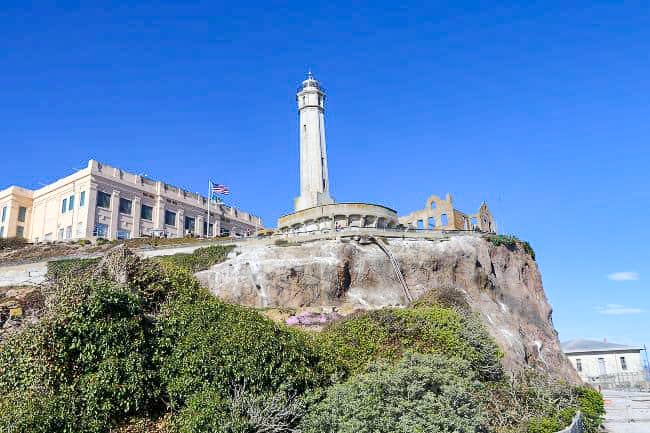
Table of Contents
History: The Rise & Fall of Alcatraz Island – From Fort to Infamous Prison
Alcatraz Island, nicknamed “The Rock,” began as a military fortress before becoming America’s most notorious federal penitentiary—housing infamous inmates like Al Capone. Today, its crumbling cellblocks and eerie guard towers stand as a haunting monument to justice, rebellion, and the untamed spirit of the island’s past.
Fortress Alcatraz
Originally named, “Isla de los Alcatraces” which translates to “Pelican Island” by Spanish explorer Lt. Juan Manuel de Ayala. They later changed the name to Alcatraz. Many fail to realize the rich history of Alcatraz. The legendary island has been a Civil war fortress with 20 inch cannons, home to the first lighthouse on the bay, a military prison and federal penitentiary. This island holds a complex history.
Civil War Era Citadel
The island was first a military citadel in the early 1860s, serving as a pivotal military position until the early 20th century. Together with Fort Point, it was an integral piece in the bay’s protection. When the American Civil war broke out, cannons were mounted along the perimeter of the island but were only used in defense. At one point, long-range iron cannons and four massive 36,000-pound, 15-inch Rodman guns surrounded the island on the high rock walls. Capable of firing up to three miles, they ensured the fort would be impenetrable. Although a perfect harbor defense battery, it faced no military action.

Note: Citadel is the lowest level of the prison block in the basement. Often referred to as “the dungeon” it is original to the building. It was part of the 1859 civil war fortress constructed to withstand an enemy attack. The sturdy, thick brick walls would later allow for the additional construction of the cell blocks (A, B, C).
Later, they decommissioned Alcatraz as a military garrison in 1907, it formally became a military prison in 1915. They tore down the older wood framed buildings and reconstructed a stronger cell block with fireproof concrete. The prison was used to house conscientious war objectors and regular prisoners. The United States Department of Justice acquired the United States Disciplinary Barracks on Alcatraz in October 1933, and the island became a federal prison in August 1934.
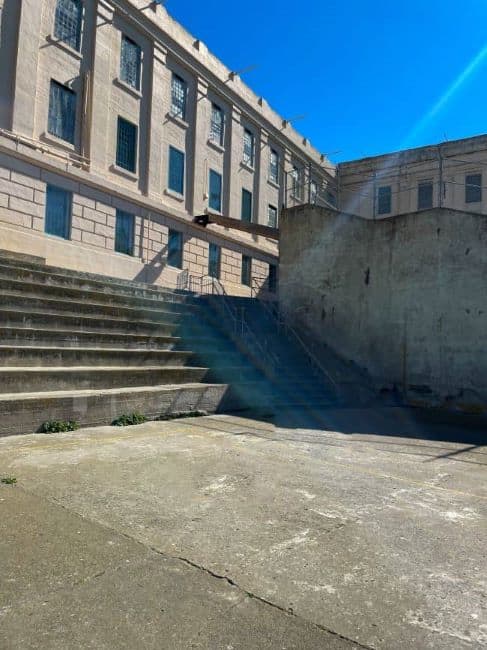
Inside the Walls: Visiting Alcatraz Island’s Infamous Penitentiary on ‘The Rock’
Although “the Rock” didn’t start off as a high security prison, Alcatraz Island became America’s premier maximum-security prison from the 1934 until 1963. Prison officials deemed it escape-proof and prisoners transferred here knew it was the end of the line. Noted for its brutality and “the hole” where incorrigible prisoners were held for months at a time. Although there were many escape attempts.
The penitentiary housed some of the most notorious criminals. Famous inmates such as “Al” Capone, George “Machine-Gun” Kelly, Alvin Karpis (the first “Public Enemy #1” Arthur “Doc” Barker, “Whitey” Bulger, Mickey Cohen, and Robert Stroud, the Birdman of Alcatraz. Robert F. Kennedy ordered the penitentiary closed on March 21, 1963. The island joined the National Park Service system in 1972. They also designated it as a national historic site in 1986.
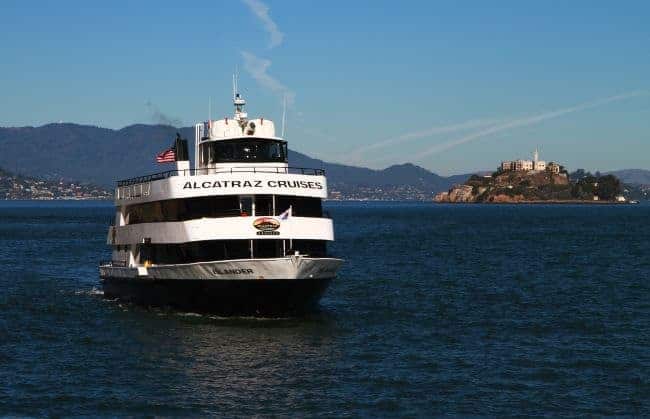
Planning Your Alcatraz Journey: Visiting Alcatraz Island & Booking Alcatraz Island Tours
The National Park Service operates the tours on the island. Alcatraz Cruises is the official ferry provider to Alcatraz Island. There are four tours that visitors can choose. Day or evening tours, behind-the-scenes tours, and combined Angel Island-Alcatraz Island tours. The island is open year round except Thanksgiving, Christmas and New Year’s Day. Boarding takes place 30mins before departure, so give yourself plenty of time.
Note: Be forewarned, there are other cruise companies that say go to the island but they don’t dock there, they cruise by the island only.
The ferry ride from Pier 33 near Fisherman’s Wharf to the island is 20 minutes each way. Although tickets sell quickly, a limited amount of same day tickets are available on a first-come, first-served basis. Departures are available every half hour throughout the day, beginning at 8:45 am. Once on deck, you could choose to sit inside near a window or outside on the top deck observation deck. I chose the latter. On the ride to the island; I was soaking in the views of the Golden Gate Bridge and the city skyline, taking photographs. Bring a heavy jacket if you are doing the morning tour. It was very foggy and cold traditional bay area fare. They have a snack bar with water, soft drinks and snacks for purchase. There is no food or drink available on the island.
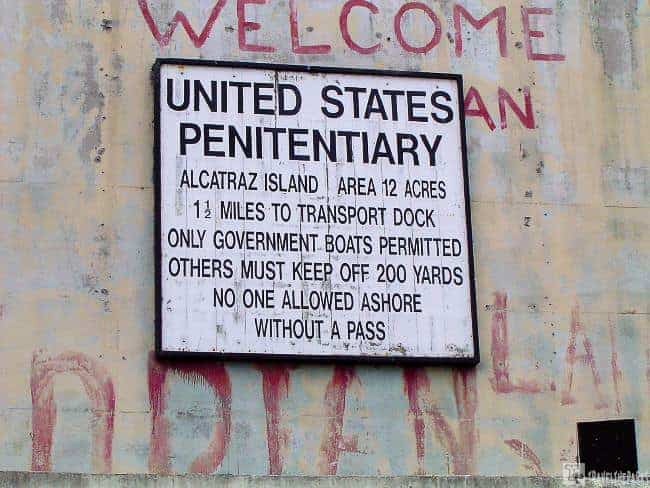
Arrival – The Dock Area
Once you arrive on the Alcatraz Island “the Rock”, there is a quick 5-minute orientation by a park ranger. The ranger offices/first aid station is the small building overshadowed by the larger barracks building.
Tip: For a $1 donation, pick up a park brochure. “Discover Alcatraz, A Tour of the Rock.”
Today most visitors to the island take advantage of the Cellhouse free audio tour. I opted for my first trip to take the 2-hour behind-the-scenes tour with Ranger John. Subsequent trips to the island, I’ve taken the self-guided audio tour narrated by the voices of 4 former prison officers and 4 former Alcatraz.

Things to Do at Alcatraz Prison “The Rock”
Explore the infamous Alcatraz Island and discover its rich history, haunting prison cells, and stunning views of San Francisco Bay. Take self-guided audio tours, wander the eerie cellhouse, spot native seabirds, and learn about the island’s fascinating past. Whether you’re into history, wildlife, or breathtaking scenery, Alcatraz offers an unforgettable day trip packed with unique experiences.
The Dock: Gateway to Freedom or Captivity
The distance between the dock and Alcatraz prison is about 1/4 mile, and the elevation change is 130 feet. It is the equivalency of climbing 13 stories, and it is rugged and steep. If you have limited mobility issues, they provide a shuttle. Engineers blasted the switchbacks out of solid rock in the 1850s during the first construction phase. I was a little winded once I reached the top.
Note: Wear comfortable, sturdy shoes during your visit as there are steep inclines and rocky foot trails.
The Sentinel Gate: Entrance to Alcatraz
One of the first stops is the guardhouse/sallyport. It is the oldest building built in 1867. This was the first line of defense for the dock. All visitors/prisoners had to enter through the heavily fortified guardhouse. Originally, a drawbridge and rifle positions created a gauntlet that was considered almost impenetrable.
As you make your way up the hill, you see the restored watchtower. It is the only remaining of six crewed freestanding towers that were on the island.

Alcatraz Island’s Social Hubs: The Post Exchange, Officers’ Club, and Chapel
They constructed this building in 1910 as a general concessions store for the soldiers and their families. Once the island became a prison, they converted it into a multi-use PX with a bowling alley. Recreation hall, gymnasium. Today, all that remains is the hollowed out structure. It was one causality of the Indian occupation. Next to the postal exchange is the chapel. However, most records show they used it as bachelor quarters.
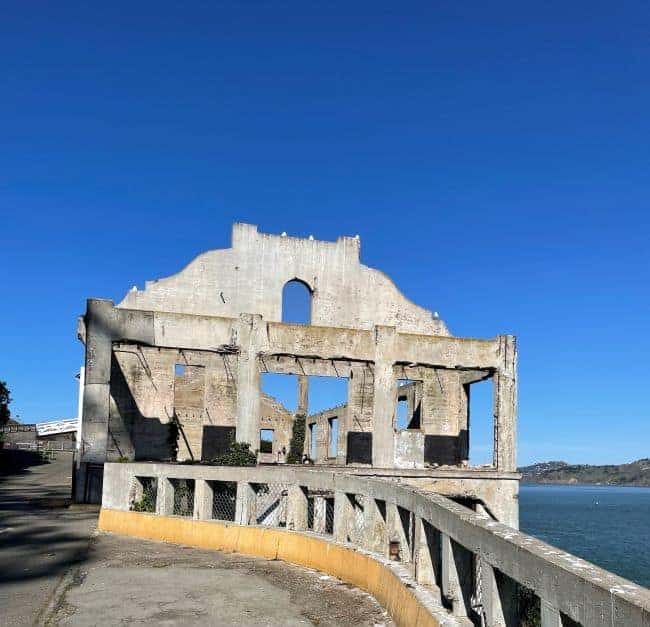
Barracks 64: Residential Life on ‘The Rock’
Inside the large four-story building that originally was a military barracks built in 1865. They renovated the building in 1963 into apartments to house staff, and the guards and their families. Later, additional housing was carved from the parade grounds. However, these were all bulldozed after the occupation of 1971. Still significant today, the barracks-Building 64 is the only intact army-era residential structure remaining on the island. Today the 10 foot thick walls house the theater and bookstore.
If you are new to the story of Alcatraz, I suggest first stopping to see the 17-minute introductory video, “Alcatraz: Stories from the Rock.” The award-winning video/exhibit, “WE HOLD THE ROCK,” produced by the National Park Service and the Golden Gate National Parks Conservancy, is in the China Alley exhibit and “Alcatraz and the American Prison Experience,” highlights the story of life through the eyes of the families that lived here and the history of American prisons.
Note: Interesting fact is that the guards could bring their families to the island.

Alcatraz Island’s Warden’s Quarters and Historic Lighthouse
James A. Johnston was the first to stay in the Hoe House or Wardens House. They constructed the 15-room luxury Mission Revival home in 1921. They held lavish dinner parties in the terraced gardens with grand views of the city. During its tenure, the mansion was home to four wardens and their families. The lavish warden’s house burned down during the AIM (American Indian Movement) Occupation of Alcatraz on June 1, 1970.
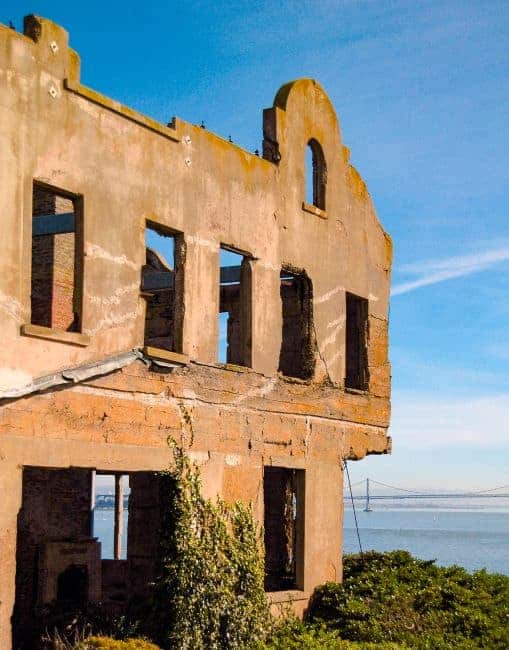
Alcatraz Lighthouse is the oldest operating lighthouse on the West Coast. The first lighthouse keeper lit the oil lamp on June 1, 1854. The 1906 earthquake damaged this smaller lighthouse. An 84-foot tall tower outfitted with a Fresnel lens replaced it. The island continued to house a keeper until 1963, when the US Coast Guard automated and took control of the light. Although the keeper’s quarters were destroyed by fire during the Indian occupation, the lighthouse tower still firmly stands today. The current lighthouse has an electric light and foghorn.

The Cellhouse: Heart of the Prison
Included with your ticket is the self-guided Cellhouse Audio Tour, which lasts approximately 45-60 minutes. Much of the narration is told from the viewpoint of both actual correctional officers and former prisoners. Although it may have been the chilly weather, listening to the stories gave me goosebumps as they detailed life at Alcatraz. The audio is available in multiple languages and is now a downloadable app you can use with your cell phone. The tour conservatively takes about 2-3 hours. This is where the true adventure begins.

Alcatraz’s Harshest Cells: Cell Block A and The Dungeon Revealed
First, you enter the steel-reinforced cellhouse that was considered a modern marvel in 1934 when the maximum security prison opened. Skylights, electrical lights, metal detectors, tool-proof bars and steam heat were state-of-the art. Cell block-A is part of the original prison and was never refurbished. It did not house inmates and was only used for offices and storage. There is a stairway leading to the Dungeon where they held prisoners in solitary prior to 1938. The dungeon was dark and dismal. I couldn’t imagine military POW prisoners being held in such harsh conditions for weeks at a time. Virtual tour of the cellhouse dungeon.
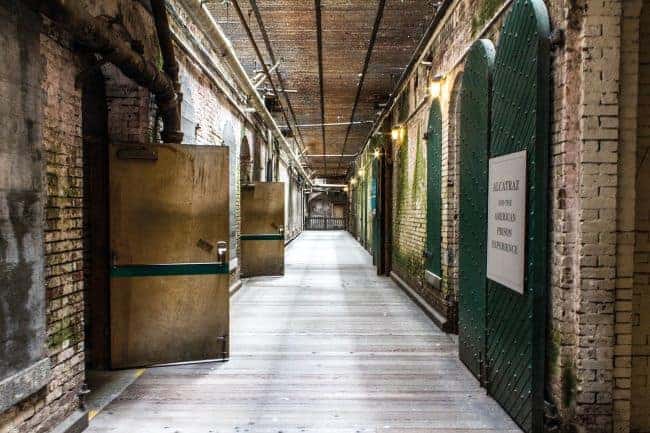
Exploring the Midsection: Cell Blocks B & C on ‘The Rock’
Returning to the main cellhouse, you enter Broadway. The central corridor for Cell Blocks C & D housed the “main line”, or general population of Alcatraz. All I could see were the endlessly stacked, empty cells. Build three-tiers high, one on top of the other in seemingly endless rows totaling 336 cells. It was an eerie feeling strolling through the hallways, stepping into the empty cells. They outfitted each cell with a bed, a desk, and a sink, and toilet. None of the cells backed onto an outside wall. Another deterrent. I know visualizing spending 14-23 hours a day in one of these cells left a powerful impression upon me. The inmate’s shower room was equally haunting as I imagined the dozens of individuals marched in to shower twice a week with no privacy whatsoever.

They Call it the Slammer
During one of the night tours, the ranger demonstration of the slamming of the cell doors. He pulled on a series of big levers, the last a long steel bar. He calls out, “Rack ’em!” and all the cell block doors slammed shut. Hearing it echo through the cell block, I could only imagine how the prisoners must have felt. How quickly the realities of daily life must have set in being in these tiny 9-foot by 5-foot cells.
For me, the most thrilling part of the tour was seeing the actual cells (138, 150 & 152) where the Anglin brothers and Frank Morris, the mastermind behind the 1962 island, escaped. Ingeniously, he chiseled away at the weak concrete surrounding the wall. They used spoons to chip away the air vent that lead to a utility corridor directly behind the cells. Here you can see a recreation of the cell, including the paper mache vent cover used to fool the guards. There were 36 escape attempts from Alcatraz. Twenty-three were caught, guards shot and killed six, and two drowned.

The Segregation Unit: Life in Solitary at Alcatraz’s Cell Block D
They named this like all the other areas of the cellhouse. Cell block D was the Sunset strip after famous American streets or landmarks. This was a segregation or treatment level unit and had electrically controlled cell doors. The cell block sent shivers down my spine. These cells housed the worst of the worst-the most dangerous and violent offenders. The bleakness in the isolation cell. Prisoners spent 24-hours a day, often in the dark for days, weeks or years. The ranger stated that The Birdman of Alcatraz inhabited cell 42 in D-Block in solitary confinement for 6 years. “The Hole” was cells 9–14 at the end of D-Block. Later, he transitioned to the prison hospital.

The Prison Hospital: Behind Bars Care
The wing became operation in 1912. It provided medical services to the correctional offices, their families, and the prisoners. The ward comprises doctor’s offices, surgical and recovery facilities. It housed at one time the Birdman- Robert Franklin Stroud. Because of his violent nature, they isolated him to prevent him from inciting a riot with the other inmates and officers. Stroud spent 11 years here.

The Mess Hall: Prisoners’ Daily Life
A small corridor called “Times Square” on the western end of the cellhouse leads to the dining hall. Corrections officers held inmates to a strict daily regime. Eating at precise times throughout the day at tables designed to seat 6-10. Armed guards required inmates to be silent during the meal. The security was tight; they monitored closely. Inmates passed through a metal detector and silverware was meticulously counted after each meal. Attached to the ceiling were tear gas canisters that operated by remote control. The kitchen had a locked knife shadowboard where guards could immediately see if any were missing. Prisoners of excellent character helped to prepare the food. They served meals cafeteria style, and the food was the best in the entire prison system.

The Library: Books Behind Bars
Cell Block D housed the prison library, where inmates were permitted to borrow up to three books, in addition to a bible and dictionary. Even with censorship of the texts, the library held a collection of 10,000 to 15,000 books.
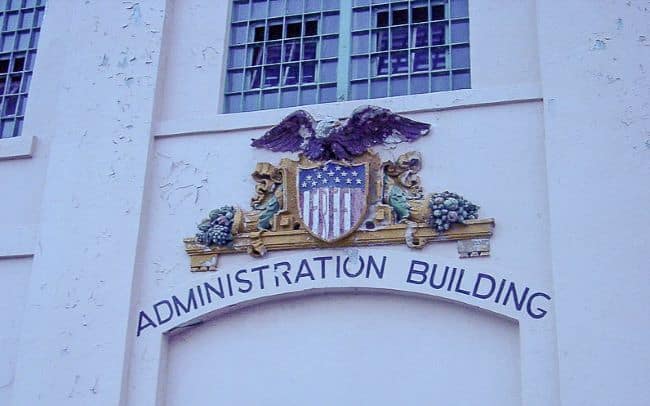
Behind the Desk: Administrative Offices at Alcatraz Island Prison
Inside the administration area of the cellhouse is the Wardens Office, Armory, communication center, the prison guard’s control room, and the visitation area. The visitation area had bullet-proof glass installed to prevent an uprising. In the control room, guards ran their 24/7 oversight of the cell block. They equipped each room as if it was still operational. More comfort than that afforded the convicts.
Where Time Stopped: The Morgue at Alcatraz Island
The US military built the morgue in 1910. Outfitted with three vaults and an examination table, they mainly used the building for storage today. They only used once it to keep a deceased prisoner overnight.

The Yard: Moments of Freedom
Next are the recreation grounds, where prisoners could only see a sliver of the golden gate bridge. 8 foot tall brick walls surround the area with by an 8-foot fence topped with razor wire.
The Industries: Work and Rehabilitation
The prison originally used the building as a clothing factory, dry cleaning, furniture construction and laundry. They needed mindful distraction, so they rewarded those with moral behavior with a job. This relieved the boredom and social isolation felt by most inmates. They have refurbished recently this building and have interesting exhibits that detail the Indian occupation- Red Power on Alcatraz, Perspectives 50 Years Later.

Prison Labor at Alcatraz: Inside the Model Industries Building
They built this building in 1922 by the US Army. Its primary purpose was to provide vocational training in blacksmithing, and other trades providing work for the prisoners. It originally housed the laundry facility until they opened New Industries building. Part of the reason it closed was the fact that there were eight escape attempts. Interesting fact is, the building shifted closer to the cliff edge. They later reinforced it with rock. Today it is all but a rusted shell. The other buildings, the powerhouse and the water tower are off limits to visitors.
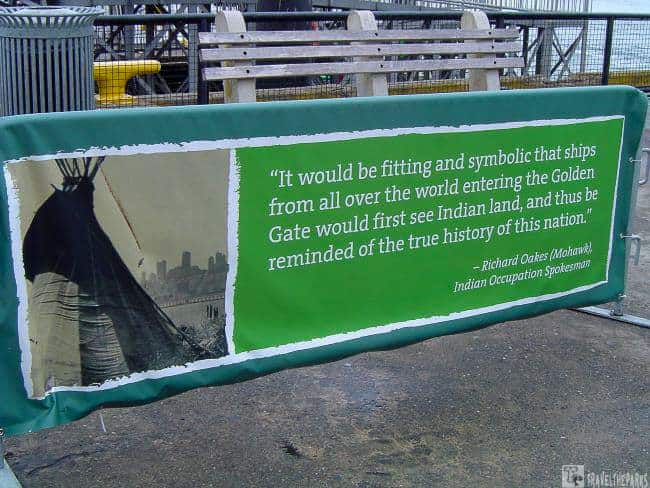
1969 Occupation of Alcatraz
In November 1969, a group of Native American activists led by charismatic Richard Oakes, a Mohawk from Akwesasne. Oakes, a student studying at San Francisco State College, recruited other students and urban Native American people. He became the spokesperson for the Red Power Movement led to many changes in federal Indian policy. Specifically, his actions help to establish the policy of Indian self-determination. The “Indians of All Tribes” occupied the island for over 19 months. Tragically, in January 1970, Oakes teenage stepdaughter succumbed to injuries from a fall down a stairwell on the island. Not long after, he left the island. Without Oakes’ leadership, the occupation fell into disarray. The US government removed the remaining occupants in 1971. Oakes continued his activism about indigenous peoples’ rights. Sadly, he was murdered at the age of 30 during a confrontation with Michael Oliver, who was later acquitted.

Hike the Agave Trail
The trail is only an easy 0.6 mile walk around the southernmost tip of the island. The trail begins at the dock, passing the sign that states, “persons procuring or concealing escape of prisoners are subject to prosecution and imprisonment.” A stone path ends at a set of flagstone stairs that rise onto the parade grounds to spectacular views of the Golden Gate Bridge and Marin headlands.
The US Army placed the namesake succulent, “Agave” plants in the 1930s and 1940s. Four varieties of the sharp, spiky plant grow on the rocky shoreline. They do particularly well in this harsh climate. They also created a barrier to the shoreline to prevent prisoners from escaping. Tidal pools created by the blasted rock debris showcase colorful anemones and other marine life.
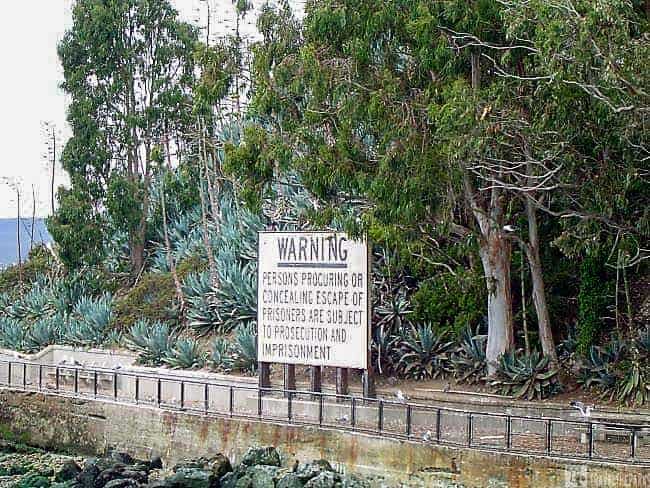
Solitude off the Beaten Path
The trail is off the beaten path, a pleasant reprieve from the crowds. I am enjoying the quiet today, sitting on one of the many park benches taking in the grand views of the city skyline. It was a bone-chilling experience walking the trail in the cool wind driven fog. The wildlife has taken back the island. Especially the Western Gulls, which hover masterfully on the breeze and swoop down to harass unsuspecting tourists. The path is closed January through September to protect nesting birds. Specifically, a large colony of Western Gulls nests amongst the rubble piles. These scattered remnants were from the apartments that housed the correctional officers and their families. They razed the apartments in 1971after until the Indian occupation of the island ended.
NOTE: Please Do Not feed any of the birds.
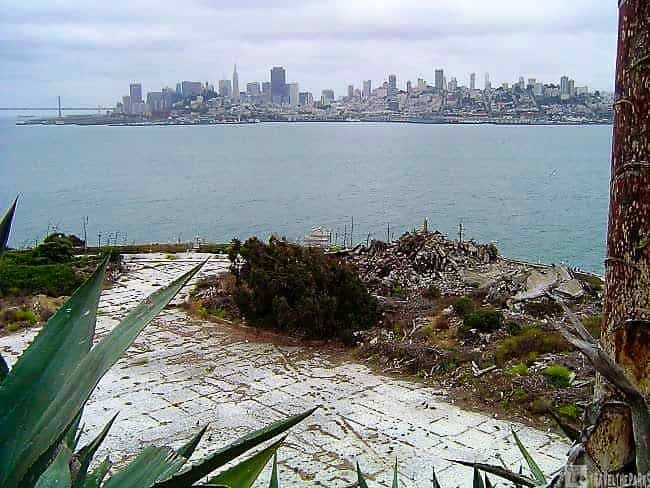
The Gardens of Alcatraz
They offer early morning docent-led tours of the Officers’ Row gardens, rose terrace and hillside flowerbeds. The garden is home to over 250 species, most of them sustainable, drought tolerant, able to withstand the harsh climate. Prison staff and their families maintained the gardens to ease the bitterness of their surroundings. Fred Reichel, the warden’s secretary in the 1930s, took an interest in the beautification of the inhospitable island. Working with the California Horticultural Society, he helped to create a small slice of heaven. The inmates’ garden is still being maintained. The historical marker for the area quoted a prisoner: “tending this garden makes me feel like there’s a purpose to my life.” Today, the Golden Gate National Parks Conservancy has meticulously preserved the gardens. The best viewing of the gardens is from January through March.
The natural beauty of the island, I mean really breathtaking views that make you wonder. I can’t believe this was once a historical maximum security prison.
Note: I recommend doing the Early Bird Tour. This is the first boat of the day, and it is the least crowded.

Final Thoughts: Alcatraz Island ‘The Rock’
Alcatraz more than exceeded my expectations. There is so much to explore and I enjoyed every minute! The audio tour is a must for you to immerse in the genuine experience. Remember to check in at the gift shop to get your National Park Passport Stamp. I suggest putting this on your list of things to do in San Francisco. It is really captivating and you won’t be disappointed. I still asked the question. Did Frank Morris and the Angling brothers actually escape the infamous Alcatraz Island, or did they succumb to the chilly waters and the many sharks in the bay?

Have you visited Alcatraz? What did you think? What did you like the most? Share in the comments below your thoughts on Alcatraz.

